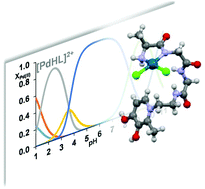Pd(ii)-Complexes of a novel pyridinone based tripeptide conjugate: solution and solid state studies†
Abstract
A novel peptide conjugate (H(L2)) incorporating N-donors of the peptide backbone and an (O,O) donor set of a hydroxypyridinone moiety is synthesized and characterized. This ambidentate chelating ligand is intended to develop Co(III)/Pt(II) heterobimetallic multitargeted complexes with anticancer potential. To explore its metal ion binding ability the interaction with Pd(II) (as a Pt(II) model but with faster ligand exchange reactions) was studied in aqueous solution by the combined use of pH-potentiometry, NMR and HR MS. In an equimolar solution H(L2) was found to bind Pd(II) via the terminal amino group and increasing number of peptide nitrogens of the peptide backbone over a wide pH range. Around physiological pH an (N,N) and (O,O) chelated 2 : 2 minor species was also identified. At a 2 : 1 Pd(II) to ligand ratio the formation of dinuclear species, [Pd2H–x(L2)] (x = 1–4), with high stability and with the involvement of the (O,O) chelating set of the ligand too, was demonstrated. Reaction of H3(L2)2+ with Pd(II) in the presence of chloride ions at pH ∼ 2.0 afforded [PdH(L2)Cl2]·2H2O (3) in a solid state whose molecular structure was assessed by single crystal X-ray diffraction. The structure of 3 revealed that Pd(II) is coordinated by a (NH2, Namide) chelate of the ligand in a square planar fashion. It also indicates that under suitable conditions a 2N coordinated Pd(II) complex can also be obtained even in the presence of four available nitrogen donors in the chelatable position in the ligand most likely due to its neutral charge and the decreased conditional stability of the amide-involved chelate(s) under acidic conditions. Reaction of H(L2) with [Co(tren)]3+ (tren = tris(2-aminoethyl)amine) revealed the exclusive coordination of (L2)−via its (O,O) chelate to the metal core while treatment of the Co-complex with Pd(II) resulted in the formation of a Co/Pd heterobimetallic complex in solution with (NH2, Namide) chelated Pd(II). Reaction of 3 with 9-methylguanine indicated the N7 coordination of this simple DNA model to Pd(II) in a 1 : 1 ratio.



 Please wait while we load your content...
Please wait while we load your content...